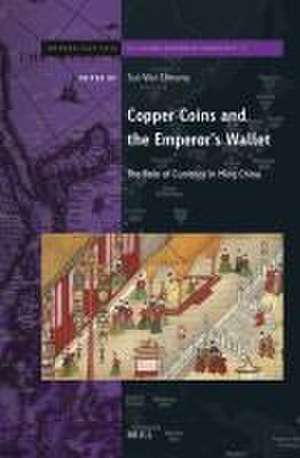Copper Coins and the Emperor's Wallet: The Role of Currency in Ming China: Brill's Series on Modern East Asia in a Global Historical Perspective, cartea 09
Autor Sui-Wai Cheungen Limba Engleză Hardback – 24 oct 2023
In this revealing history of Ming China, Cheung argues that especially after the breakdown of the household registration system, the aim of the Ming coinage system was to create a new source of income in order to maintain the emperor's domain in Beijing.
Preț: 634.14 lei
Preț vechi: 746.05 lei
-15% Nou
Puncte Express: 951
Preț estimativ în valută:
121.36€ • 126.23$ • 100.19£
121.36€ • 126.23$ • 100.19£
Carte disponibilă
Livrare economică 25 martie-08 aprilie
Preluare comenzi: 021 569.72.76
Specificații
ISBN-13: 9789004687523
ISBN-10: 9004687521
Pagini: 187
Dimensiuni: 155 x 235 mm
Greutate: 0.4 kg
Editura: Brill
Colecția Brill
Seria Brill's Series on Modern East Asia in a Global Historical Perspective
ISBN-10: 9004687521
Pagini: 187
Dimensiuni: 155 x 235 mm
Greutate: 0.4 kg
Editura: Brill
Colecția Brill
Seria Brill's Series on Modern East Asia in a Global Historical Perspective
Notă biografică
Sui-Wai Cheung (D. Phil., Oxford) is Professor of History at the Chinese University of Hong Kong. He has previously published The Price of Rice: Market Integration in Eighteenth-Century China (CEAS, Western Washington University, 2008) and Colonial Administration and Land Reform in East Asia (Routledge, 2017).
Cuprins
List of Figures, Tables, and Maps
Ming Dynasty Emperors
Ming Weights and Measures
Introduction: Currency and Taxation in Ming China, 1368–1644
1 How Precious Is a Precious Note? State Currency in the Early Ming, 1368–1435
1 The Value of Paper
2 Managing an Empire Without Money
2.1 Household Registration for Goods and Services
2.2 Moving the Capital South
2.3 Eunuchs: the Emperor’s Servants and Gatekeepers
2.4 Labor Services and In-Kind Taxes
2.5 The Lijia
3 From Copper to Rice to Precious Notes
4 Civil War, a New Capital, and a Surfeit of Precious Notes
4.1 Moving the Capital to Beijing
4.2 Precious Notes for Capital Officials
4.3 Taking Precious Notes Out of Circulation: the Salt Tax and Crime Restitution Fees
5 Reopening China to Trade
5.1 The Treasure Fleet
5.2 Building the New Capital in Beijing
6 Retrieving Precious Notes: Commercial Fees and Charges
7 Conclusion
2 From Illegal to Official: Copper and Silver, 1400–1487
1 Recession, Piracy, and Foreign Trade
2 Reopening China: Silver in the Market
2.1 Feeding the Capital: Tribute Rice and the Grand Canal
2.2 Commuting the Grain Tax: The Gold Floral Silver Reform
2.3 Silver and the Precious Note
3 Copper Coins in a “Filthy” Reign
3.1 Government Taxes and Fees in Copper Cash
4 Counterfeit Coins and Gresham’s Law
5 Conclusion
3 Household Registration, Foreign Trade, and the Emperor’s Table, 1444–1566
1 Maritime Merchants and Household Registration
2 The Emperor’s Table
3 The Emperor’s Coffers
4 An End to Extravagance?
5 Copper Coins as Income
6 Prodigal Emperors
6.1 The Zhengde Emperor (1505–1521): Extortion and Government Charges
6.2 The Jiajing Emperor (1521–1566): Brass Coins
7 Closing the Baoyuan Mint
8 Conclusion
4 Coins for the Government, 1567–1644
1 Coins for the Country and the People
1.1 Coins for the Ministries
1.2 Provincial Mints
1.3 “Golden Backs” for the Taicang Treasury
1.4 Renting Furnaces at the Nanjing Mint
2 Back Into the Emperor’s Wallet
3 Conclusion
5 Conclusion: Small Change and State Administration in Ming China
Works Cited
Glossary
Index
Ming Dynasty Emperors
Ming Weights and Measures
Introduction: Currency and Taxation in Ming China, 1368–1644
1 How Precious Is a Precious Note? State Currency in the Early Ming, 1368–1435
1 The Value of Paper
2 Managing an Empire Without Money
2.1 Household Registration for Goods and Services
2.2 Moving the Capital South
2.3 Eunuchs: the Emperor’s Servants and Gatekeepers
2.4 Labor Services and In-Kind Taxes
2.5 The Lijia
3 From Copper to Rice to Precious Notes
4 Civil War, a New Capital, and a Surfeit of Precious Notes
4.1 Moving the Capital to Beijing
4.2 Precious Notes for Capital Officials
4.3 Taking Precious Notes Out of Circulation: the Salt Tax and Crime Restitution Fees
5 Reopening China to Trade
5.1 The Treasure Fleet
5.2 Building the New Capital in Beijing
6 Retrieving Precious Notes: Commercial Fees and Charges
7 Conclusion
2 From Illegal to Official: Copper and Silver, 1400–1487
1 Recession, Piracy, and Foreign Trade
2 Reopening China: Silver in the Market
2.1 Feeding the Capital: Tribute Rice and the Grand Canal
2.2 Commuting the Grain Tax: The Gold Floral Silver Reform
2.3 Silver and the Precious Note
3 Copper Coins in a “Filthy” Reign
3.1 Government Taxes and Fees in Copper Cash
4 Counterfeit Coins and Gresham’s Law
5 Conclusion
3 Household Registration, Foreign Trade, and the Emperor’s Table, 1444–1566
1 Maritime Merchants and Household Registration
2 The Emperor’s Table
3 The Emperor’s Coffers
4 An End to Extravagance?
5 Copper Coins as Income
6 Prodigal Emperors
6.1 The Zhengde Emperor (1505–1521): Extortion and Government Charges
6.2 The Jiajing Emperor (1521–1566): Brass Coins
7 Closing the Baoyuan Mint
8 Conclusion
4 Coins for the Government, 1567–1644
1 Coins for the Country and the People
1.1 Coins for the Ministries
1.2 Provincial Mints
1.3 “Golden Backs” for the Taicang Treasury
1.4 Renting Furnaces at the Nanjing Mint
2 Back Into the Emperor’s Wallet
3 Conclusion
5 Conclusion: Small Change and State Administration in Ming China
Works Cited
Glossary
Index







